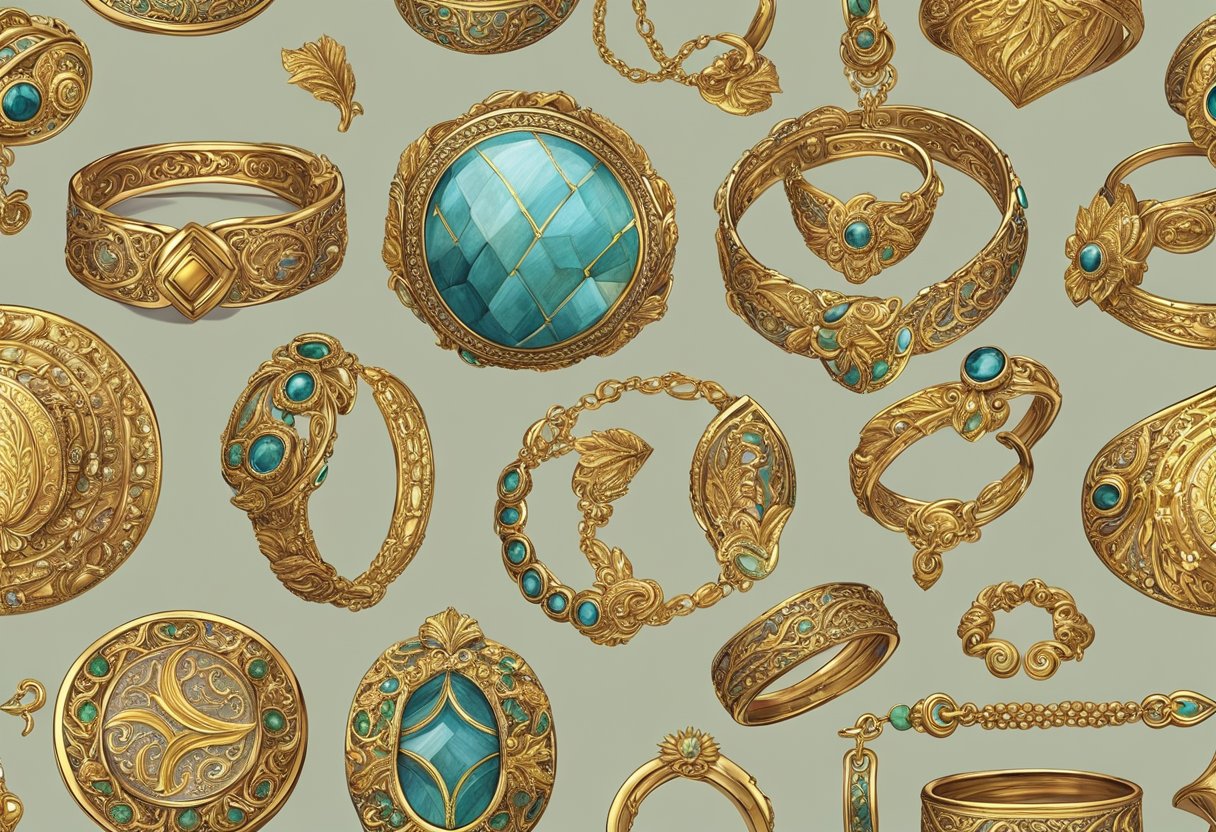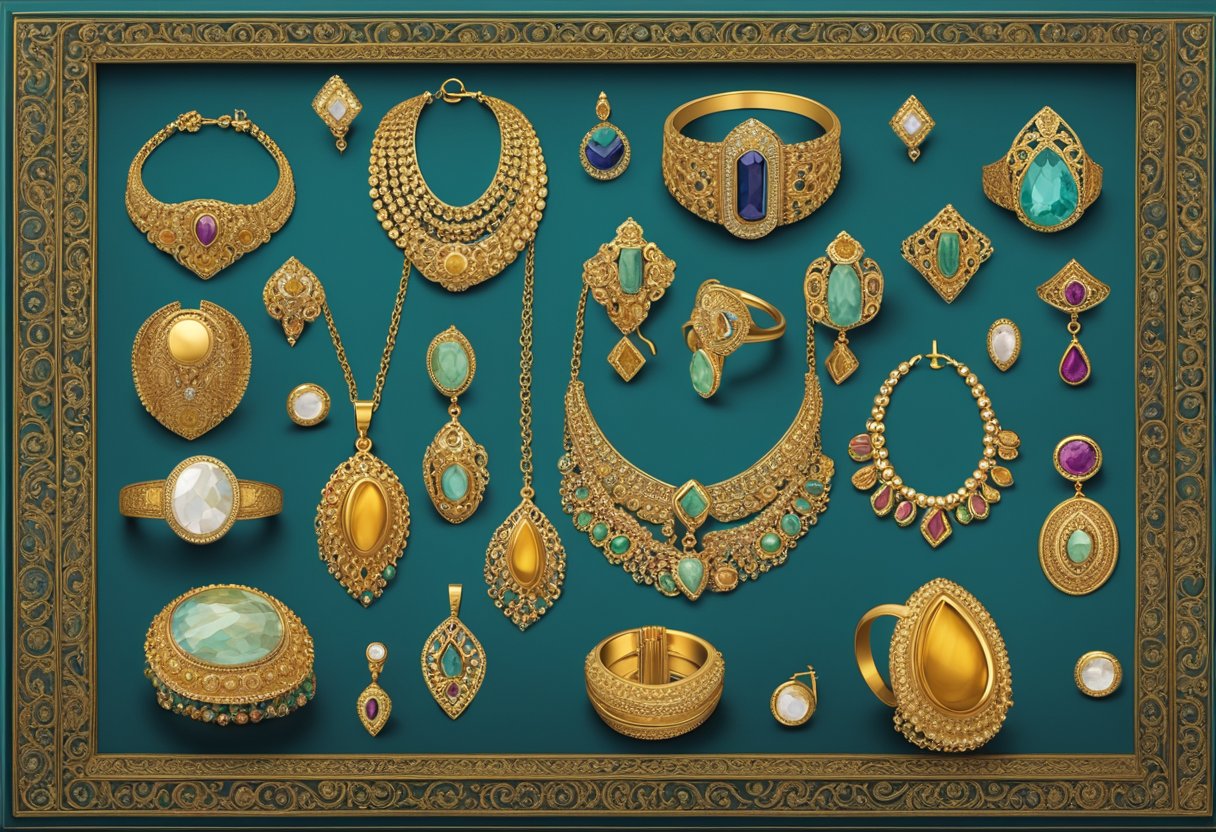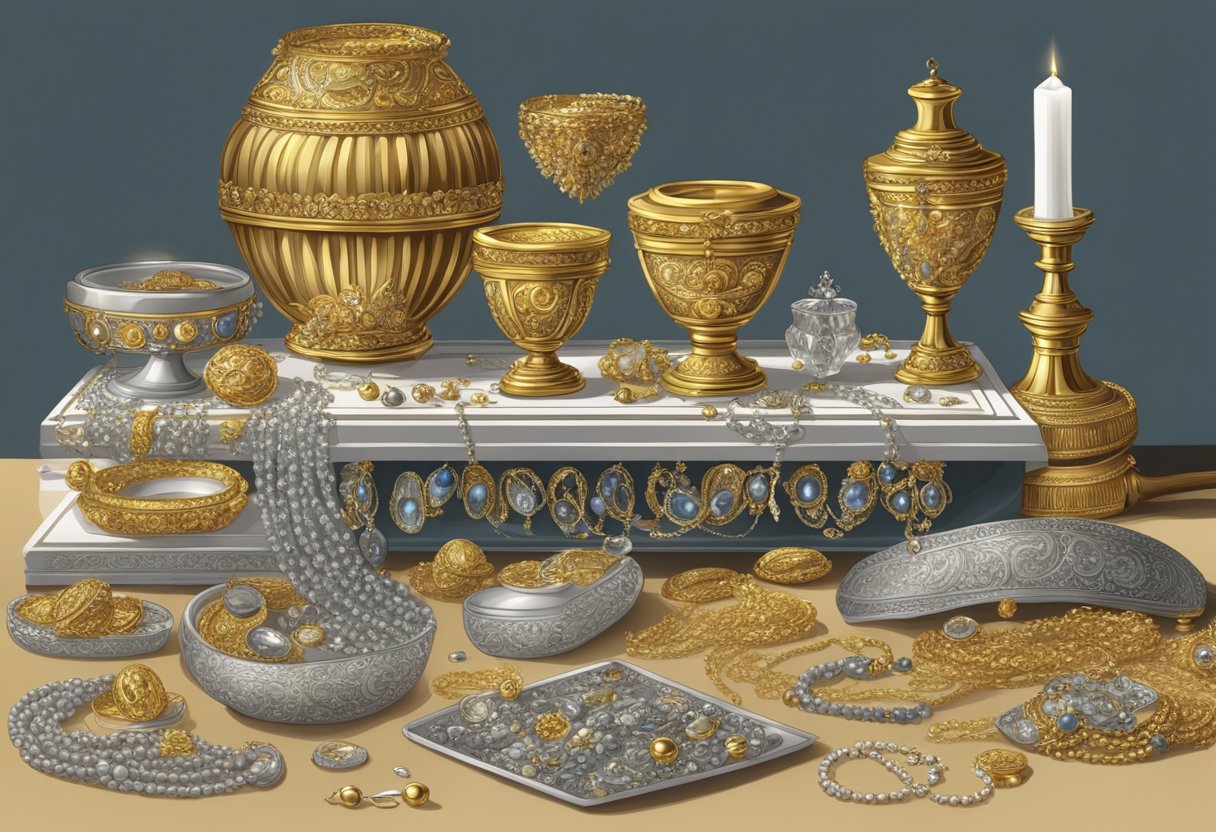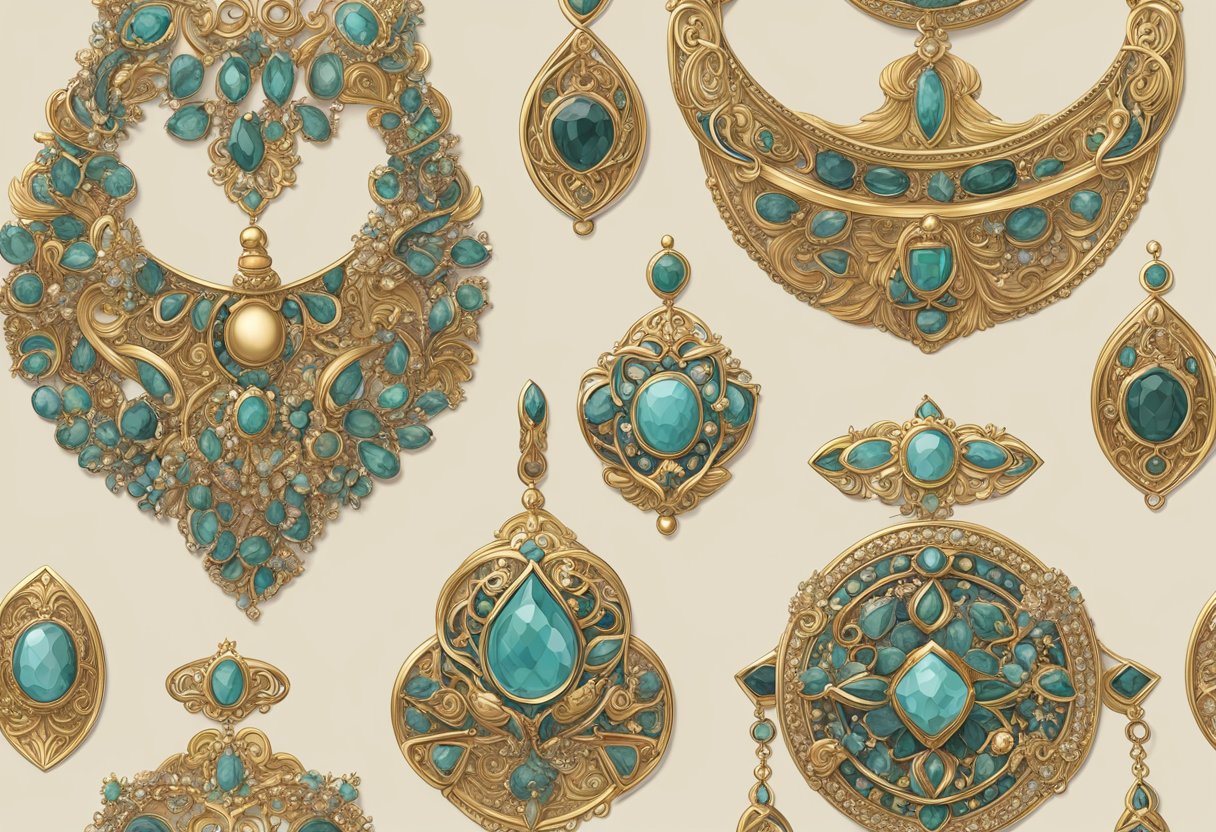Roman jewelry encompasses a vast array of adornments that were not only valuable in their material worth but also served as indicators of social status, wealth, and personal taste during the Roman Empire.
These items were crafted using a variety of materials, including gemstones, gold, and silver, and reflected the high level of craftsmanship that Roman artisans achieved.
Beyond mere decoration, jewelry in ancient Rome held significant symbolism and was integrated into various aspects of everyday life and ritual practices.

The typology and variety of jewelry worn by Romans was extensive, ranging from rings, necklaces, and earrings to more complex items like fibulae and torcs.
These items were adorned by men, women, and children across different societal ranks.
The trade and distribution of jewelry, along with the sharing of cultural influences across the Empire, contributed to a diverse assortment of designs that are still admired today for their beauty and the glimpse they offer into a past culture’s daily life.
Key Takeaways
- Roman jewelry was a reflection of wealth, status, and personal taste in the Roman Empire.
- Craftsmanship and a variety of materials were characteristic of the jewelry, with symbolism playing a key role.
- The typology of Roman jewelry was diverse, impacting many aspects of Roman life and culture.
Historical Context of Roman Jewelry
Roman jewelry encapsulates a storied past, reflecting the grandeur of the Roman Empire and its interactions with various cultures.
Its evolution was influenced by social hierarchies and expanding trade networks.
Influence of Greece and Egypt
Ancient Roman jewelry revealed a strong Greek and Egyptian influence, where design and motifs were often borrowed and adapted.
Etruscan techniques, such as granulation and filigree, were sophisticated and reflected in the luxurious items worn by the elite.
From Greece, intricate designs and the use of precious stones became staples in Roman adornments, carrying connotations of power and wealth.
Expansion and Trade
As Rome expanded, it absorbed many Mediterranean territories, including Persia, enriching its cultural and artistic practices.
With expansion, trade flourished, making rare gems and materials accessible.
This exchange facilitated the production of an array of jewelry, from ornate gold pieces to more modest bronze items, which would distinguish social status among senators, bureaucrats, and plebeians.
Socio-Economic Significance
In the Roman Empire, jewelry was not merely decorative but a display of social hierarchy and economic capability.
Items like signet rings could signify power and authority, as they were used to seal documents.
Senators and wealthy individuals adorned themselves with elaborate jewelry to denote status, while lower classes were restricted by sumptuary laws, reflecting the socio-economic stratification in Rome.
Materials and Craftsmanship
Roman jewelry was not just an embodiment of wealth and status but also a showcase of the era’s superior materials and artisanship.
The combination of diverse materials and evolving techniques allowed Roman jewelers to create pieces that were intricate and indicative of the wearer’s social standing.
Metals and Precious Stones
Metals: Roman jewelry primarily employed gold, silver, and iron.
Gold was favored for its luster and association with divine power, while silver was commonly used for its availability and aesthetic appeal. Iron was less common but valued for its strength and durability.
- Precious Stones: The Romans held gems such as emeralds, pearls, and garnet in high regard.
- Royalty and the upper classes often adorned themselves with these, considering them to represent protection and love.
- Emeralds were sought after for their vibrant green color, symbolizing fertility and rebirth.
- Pearls, fetched from the depths of the Mediterranean and Red Seas, suggested purity and were coveted for their natural beauty.
Glass and Beading Techniques
Glass: Roman jewelers were pioneers in the use of glass as a substitute for costly gems.
They incorporated colorful glass beads into their designs, creating intricate patterns that mimicked those found in nature.
- Beading Techniques: Intricate beading with glass beads was a testament to Roman craftsmanship.
- They mastered the art of threading tiny beads together, creating complex and detailed patterns on earrings, necklaces, and bracelets.
- Towards the Imperial Period, advances in glasswork saw the incorporation of millefiori, a technique featuring flower-like patterns in glass.
Innovations in Design
Roman jewelry underwent significant evolution, with designs reflecting cultural exchanges from the vast Roman Empire.
- Design Elements: They included a variety of motifs in their jewelry, representing animals, gods, and geometric patterns, which were symbolic and served as amulets.
- The use of onyx, jasper, lapis, and amethyst advanced the aesthetic appeal of jewelry pieces, often featuring them prominently in rings and cameos.
- Technical Innovations: The innovation in metalworking techniques, such as filigree and granulation, allowed for delicate and refined pieces.
- These advancements demonstrated not only the artisans’ skills but also their adaptability in incorporating various materials from conquered territories.
Typology of Roman Jewelry

Roman jewelry reflected the wealth and status of its wearer, often crafted from precious metals like gold and adorned with gems.
The various forms of Roman jewelry, ranging from rings to brooches, not only served as personal adornment but also as social indicators in ancient Roman society.
Rings and Earrings
Rings were both ornamental and functional, often signifying the wearer’s status.
Gold rings were particularly popular among the elite, while less affluent individuals commonly wore rings made from other materials.
Designs frequently featured carved gemstones or depicted figures and deities, granting rings an amulet-like significance.
Earrings were widely worn, with designs that included simple hoops, studs, and more elaborate pendants.
Both men and women adorned themselves with earrings, although the styles and frequency of wear could vary with fashion and social ranking.
Necklaces and Pendants
Roman necklaces often consisted of chains made of gold or other metals, and they could be ornamented with gems, beads, or pendants.
Pendants themselves ranged from simple gemstones to intricate designs featuring religious symbols or portraits, serving as protective amulets or indications of religious affiliation.
Elegant necklaces could also include multiple strands of pearls or beads, showcasing the luxury and craftsmanship of Roman jewelers.
Bracelets and Brooches
Bracelets were common in Roman society, crafted as simple bands or more complex articulated pieces.
Materials varied widely, with gold bracelets indicating a higher social status.
They could be smooth, twisted into torcs, or intricately patterned with filigree work.
Brooches, especially the crossbow fibula, were used to fasten garments but also held decorative and symbolic relevance.
They ranged from practical copper and bronze pieces to opulent gold brooches encrusted with gemstones. Brooches often reflected the military and political achievements of the wearer.
Other Ornamental Items
Other ornamental items in Roman jewelry included bullas, which were lockets worn by children as talismans, and various forms of snake-themed jewelry, which symbolized rebirth and immortality.
Jewelers also created hairpins, belt buckles, and shoe buckles, which could be just as lavish as other jewelry types.
These items sometimes functioned as amulets believed to grant protection to the wearer.
Jewelry Across Gender and Age

In ancient Rome, jewelry served as a significant marker of social status and personal wealth, with distinct variations observed among women, men, and children.
Women’s Jewelry
Roman women were known for their elaborate adornments. They often wore intricately designed necklaces, bracelets, earrings, and rings.
Pendants in the shape of gods and goddesses were common, symbolizing both religious devotion and opulence.
Pearls were especially prized, connoting luxury and high status.
The Etruscan Jewelry and Identity suggests that they could use these adornments to highlight certain social or familial identities.
Men’s Jewelry
In contrast, Roman men’s jewelry was more subdued but equally significant.
Signet rings were key items worn by Roman men. These were both functional, for sealing documents with wax, and demonstrative of their lineage and reputation.
Items like cufflinks or clasps also bear evidence of use, as mentioned in the study of Late Classical representations of jewelry, which could signify ties to cultural or professional affiliations.
Jewelry for Children
Jewelry for children in Rome was not merely decorative. It often carried apotropaic purposes – to ward off evil.
Bulla, a hollow pendant, was given to children to protect them from malevolent forces.
Children of wealth wore small-scaled versions of adult jewelry, which served both to adorn and to earmark their family’s social standing.
Symbolism and Function
In ancient Rome, jewelry was not merely ornamental; it played critical roles in conveying status and identity, as well as serving religious and protective functions.
These pieces were often laden with symbols and crafted to indicate the wealth of the wearer or their societal standing.
Status and Identity
Jewelry in Roman culture was a clear indicator of one’s social rank and personal wealth. For example, items such as rings with intaglio designs were often used as personal seals, indicative of authority and status.
Wealthier citizens could afford jewelry made of precious metals and gemstones, while those from lower social strata often wore simpler, less expensive pieces.
The use of the torquatus, a type of necklace, could be a sign of honor and distinction in the public eye.
Religious and Protective Uses
The Romans believed in the protective and curative properties of jewelry. Amulets and pendants were common, designed to ward off evil and ensure the health and safety of the wearer.
The bulla, for example, was an amulet worn by children to protect them from malevolent forces until they reached adulthood.
Many pieces of jewelry featured snakes or coiling snakes, seen as symbols of immortality and healing. Such motifs could serve both a religious purpose and a public declaration of personal beliefs or status.
Dressing the Dead

In ancient Rome, the interment of the deceased was a ceremony steeped in tradition, often involving the adornment of the body with jewelry and amulets believed to signify status and, in some cases, offer protection in the afterlife, conferring a sense of immortality upon the wearer.
Funerary Practices
When preparing for burial or cremation, Romans commonly dressed their dead, intricate rituals reflecting their beliefs about life after death.
It was customary to adorn the bodies with jewelry, including rings, brooches, and intricately designed necklaces.
These pieces often held deeper meaning, symbolizing the individual’s status or profession, and sometimes incorporated amulets believed to safeguard the deceased during their journey to the underworld.
Roman funerary customs varied by period and societal status, but a shared practice was the use of jewelry as grave goods.
This was especially prominent among the elite, for whom funerary rituals were crucial display moments.
Wealthy Romans might be interred with high-quality jewelry made of gold, gemstones, and other precious materials—a display of their earthly riches and perhaps a bid for favour or recognition in the afterlife.
Amulets held particular significance and were often placed among the grave goods. Their shapes and materials varied, each believed to offer specific protective powers.
For instance, an amulet shaped like a phallus was thought to ward off evil, promoting fertility and good fortune even in death.
The importance of immortality in Roman culture is reflected in the practice of dressing the dead.
By accompanying the deceased with their most valued possessions, the Romans expressed a hope or belief that some essence of their life and identity would endure permanently, transcending the mortal realm.
Legacy and Influence
The legacy of Roman jewelry is evident in its lasting influence on modern fashion and its presence in historical collections.

Roman Jewelry in Modern Fashion
Roman jewelry provides a rich source of inspiration for modern designers, with many elements of ancient design still evident in contemporary fashion.
Elements such as the use of precious metals, intricate filigree work, and coin incorporation have traversed millennia to remain prevalent in today’s jewelry pieces.
Replicas of Roman jewelry highlight the blend of Celtic and classical traditions, becoming coveted items for those appreciating historical aesthetics in a modern context.
Artifacts in Historical Collections
Museums worldwide treasure Roman jewelry as central exhibits demonstrating the artistry and sophistication of ancient Rome.
These artifacts often serve to educate about the complex interactions between the Romans and other Mediterranean cultures, including the Greeks, whose styles heavily influenced Roman artisans.
Pieces displayed range from elaborate gold necklaces to gemstone-encrusted rings, reflecting a society keen on opulence and display.
Moreover, jewelry items are frequently studied alongside sculptures and other art forms to provide a more holistic view of the Roman approach to beauty and personal adornment.
Trade and Distribution

In ancient Rome, the trade and distribution of jewelry reflected the Empire’s vast network of commercial exchanges and the skilled artisans integral to the craft. These two elements underscored the economic and cultural connections established across the empire and beyond its borders.
Local and International Trade Routes
Local trade within the Roman Empire was facilitated by an extensive network of roads that allowed for the distribution of jewelry to different provinces.
Artisans in Rome created pieces that would often find their way to markets in Gaul or Greece through these routes.
International trade routes, such as the famed Silk Road, were instrumental in the trade between Rome and distant regions.
Precious stones and materials, necessary for Roman jewelry, were imported from places like India, enriching the diversity and design of jewelry available in Rome.
The Role of Workshops and Artisans
Artisans and workshops were pillars in the Roman jewelry trade, closely connected to the supply and demand dynamics of the empire’s economy.
These craftsmen often formed collegia, which were associations akin to guilds, and they would control the trade of jewelry, honing specialized skills.
Records from an individual like Titus Manlius, a renowned Roman dictator, sometimes shed light on the importance of workshops for producing commissioned pieces for the elite.
Workshops often passed down trade secrets and skills from generation to generation, ensuring the endurance and evolution of Roman jewelry styles.
Frequently Asked Questions
The ensuing discussion provides insights into the intricacies of Roman jewelry, highlighting materials, social implications, design characteristics, museum collections, its influence on modern jewelry, and centers of production.
What materials were commonly used in Roman jewelry making?
Roman jewelry incorporated a variety of materials, from precious metals like gold and silver to gemstones such as emeralds, pearls, and garnets.
Craftsmen also used less costly materials like bone, glass, and bronze to cater to a broader audience.
In ancient Rome, the complexity and richness of jewelry often signified the wearer’s wealth and social rank.
High-quality metals and rare gemstones were typically reserved for the upper echelons of society, while more common materials were used in the adornments of the lower classes.
Can you describe some distinguishing characteristics of Ancient Roman jewelry?
Ancient Roman jewelry is recognized for its intricate designs, with motifs drawn from nature, mythology, and daily life.
Features like filigree work, engraving, and the use of colored stones helped distinguish pieces from different periods and regions.
What are some notable examples of jewelry from the Roman era on display in museums?
The British Museum and the Metropolitan Museum of Art house extensive collections of Roman jewelry.
Noteworthy are pieces from the Hoxne Hoard and the Roman-era gold jewelry found at the site of the Villa of the Papyri.
How has Roman jewelry influenced contemporary jewelry designs?
Contemporary designers often draw inspiration from the rich symbolism and intricate patterns of Roman jewelry.
The iconic use of cameos and the importance placed on jewelry craftsmanship resonate with modern aesthetics and techniques.
Where were the primary centers for Roman jewelry production and trade?
Rome, Alexandria, and Antioch were crucial centers for jewelry making and trade in the Roman Empire.
Their strategic locations facilitated the exchange of cultural influences and the distribution of jewelry across the empire.
